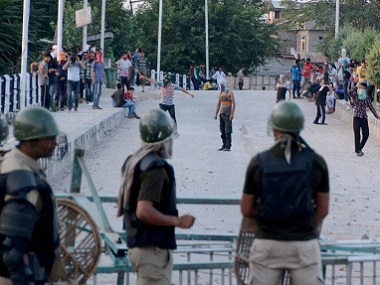A prominent young Kashmiri activist observed sadly as word spread about violence and stone-pelting on Eid on Wednesday: “If (former Jammu and Kashmir governor) NN Vohra were to go into downtown (the inner city of Srinagar) now, they would not throw a stone at him.” This activist was not the only one who drew a correlation between the change at Raj Bhawan and the upsurge of violence, demonstrations, and heckling of senior leaders in the Valley. Only time will tell, but changing the governor of Jammu and Kashmir midway may turn out to be a mistake. Stone-pelting, which had substantially reduced since Governor’s Rule began, bounced back with ferocity on Eid-ul Azha like the trajectory of a stone released from a slingshot, immediately after he was replaced. In fact, the trend of reduced pelting, which began during the Ramzan cessation of encounters by security forces, had improved further under Governor’s Rule, even though encounters had begun again. Tough control There is anecdotal evidence from senior officers that Vohra had kept a tight leash on ‘collateral damage’ by the forces, especially the killing of those not involved in militancy. [caption id=“attachment_5023711” align=“alignleft” width=“380”] Representational image. PTI[/caption] Far more important was his image. He was known among Kashmiris as a well-meaning and fair-minded man of experience, but without an ideological leaning. That went a long way to colouring perceptions of the administration since Governor’s Rule began on 19 June. It is possible that policy makers in New Delhi were lulled by the declining graph into thinking that the situation was well in hand. If so, they may have missed two submerged trends. One, despite his low profile, Vohra has become very acceptable — if not popular — among people at large. Two, the idea that militant acts and public demonstrations are sporadic, dispersed, and uncoordinated is flawed. Those who coordinate militancy and demonstrations often raise or lower the temperature, as if they were operating a fader in a sound studio. Far too often, intelligence agencies and policymakers appear to be largely oblivious to these patterns of coordination. In this light, it is quite possible that the coordinators of unrest were waiting for an opportunity to up the ante after the lull which the Ramzan gesture and the general popularity of Vohra caused. It had seemed that the removal of Article 35-A from the Constitution might give such an opportunity earlier this month. However, the Supreme Court postponed the matter to 27 August. A court verdict removing that article, either next Monday or after more hearings, might still spark an uprising that could prove more intense than the one that followed the killing of militant commander Burhan Wani in 2016. Meanwhile, by changing the governor, the Centre might have unwittingly provided just the opportunity the coordinators of violence and unrest sought. Ideological prism It seems that most of those in the corridors of power do not generally recognise the extent to which people at large in Kashmir see such moves in terms of political and ideological signalling. While people trusted the fair-mindedness they associated with the understated but firm Vohra, they generally tend to associate any governor with a political background with the BJP. Association with the BJP and RSS was a key reason why the previous PDP-led government became so unpopular. That sort of perception of the state government may return. Failure to recognise that some sections of citizens do not view a leader or a party the way some would like, can be a terribly costly miscalculation in the halls of government. A sharp polarisation has come about since 2008, between Jammu and the Kashmir Valley on the one hand and between religious communities on the other. In the minds of many residents of the state, the two axes of communal animosity overlap.
There is anecdotal evidence from senior officers that former Jammu and Kashmir governor NN Vohra had kept a tight leash on ‘collateral damage’ by security forces in the Valley
David Devadas is an expert on politics and geopolitics. Formerly a Senior Fellow at the Nehru Memorial Museum and Library, Visiting Professor at Jamia Millia Islamia, and Political Editor of Business Standard, he is currently Distinguished Fellow at the Institute for Social Sciences. He has written books on Kashmir, on youth, and on history. He has been a radio compere, guest faculty at JNU's Academic Staff College, St Stephen's College and Hindu College. He has worked for the Indian Express, The Hindustan Times, India Today, The Economic Times and Gulf News. His most impactful article, on a murder cover-up, prevented a Congress President from becoming prime minister. One led to the closure of an airline, and another created a furore and consequent clean-up in Delhi's health department. Several have correctly predicted election results in key states, and a series of reports from Srinagar made the government aware of how unsettled the situation there was in 1990. He is an alumnus of St Xavier's School, St Stephen's College, and the Indian Institute of Mass Communication. He has lived for extended periods in Geneva and Berlin, and has traveled to almost 50 countries. He enjoys various kinds of music, theatre, design, architecture and art. see more


)
)
)
)
)
)
)
)
)



